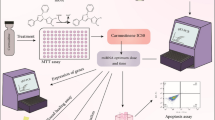Abstract
Background
Recently, several miRNAs have been determined as tumor suppressors in various cancers, such as microRNA-449a. However, the exact molecular mechanisms underlying miR-449a regulated cell proliferation and chemosensitivity in gastric cancer cells have not been well documented.
Aim
The present study was designed to test whether miR-449a mediates cell proliferation and chemosensitivity in gastric cancer cells via regulating cyclin D1 and BCL2.
Methods
In vitro, the ability of cell proliferation and cell viability were measured by MTT assay; cell cycle and cell apoptosis was detected by FCM. qRT-PCR was used to measure the expression of miR-449a. Western blot and real-time PCR assays were used to detect the expression of cyclin D1 and BCL2 in gastric cancer cell line SGC7901.
Results
miR-449a expression was downregulated in gastric cancer cell line SGC7901 and human gastric cancer tissues, compared to the gastric epithelial cell line GES-1 and matched non-tumor associated tissues. Upregulation of miR-449a reduced the proliferation of SGC7901 cells. Ectopic expression of miR-449a decreased the percentage of S phase cells, increased the percentage of G1/G0 phase cells and increased the apoptosis induced by cisplatin. Moreover, miR-449a inhibited SGC7901 cells proliferation and enhanced cisplatin chemosensitivity by downregulating expression of BCL2 and cyclin D1, respectively, via directly targeting the 3′-untranslated regions of BCL2 and cyclin D1 mRNA.
Conclusions
This is the first report to provide evidence that miR-449a could modulate cell cycle and apoptosis through regulating cyclin D1 and BCL2 expression in SGC7901 cells.





Similar content being viewed by others
References
Jemal A, Siegel R, Ward E, et al. Cancer statistics, 2006. CA Cancer J Clin. 2006;56:106–130.
Dicken BJ, Bigam DL, Cass C, et al. Gastric adenocarcinoma: review and considerations for future directions. Ann Surg. 2005;241:27–39.
Cunningham D, Allum WH, Stenning SP, et al. Perioperative chemotherapy versus surgery alone for resectable gastroesophageal cancer. N Engl J Med. 2006;355:11–20.
Liu K, Qian T, Tang L, et al. Decreased expression of microRNA let-7i and its association with chemotherapeutic response in human gastric cancer. World J Surg Oncol. 2012;10:225.
Ambros V. The functions of animal microRNAs. Nature. 2004;431:350–355.
de Moor CH, Meijer H, Lissenden S. Mechanisms of translational control by the 3′ UTR in development and differentiation. Semin Cell Dev Biol. 2005;16:49–58.
Kovalchuk O, Filkowski J, Meservy J, et al. Involvement of microRNA-451 in resistance of the MCF-7 breast cancer cells to chemotherapeutic drug doxorubicin. Mol Cancer Ther. 2008;7:2152–2159.
Boren T, Xiong Y, Hakam A, et al. MicroRNAs and their target messenger RNAs associated with ovarian cancer response to chemotherapy. Gynecol Oncol. 2009;113:249–255.
Ji Q, Hao X, Meng Y, et al. Restoration of tumor suppressor miR-34 inhibits human p53-mutant gastric cancer tumorspheres. BMC Cancer. 2008;8:266.
Yang N, Kaur S, Volinia S, et al. MicroRNA microarray identifies let-7i as a novel biomarker and therapeutic target in human epithelial ovarian cancer. Cancer Res. 2008;68:10307–10314.
Noonan EJ, Place RF, Pookot D, et al. miR-449a targets HDAC-1 and induces growth arrest in prostate cancer. Oncogene. 2009;28:1714–1724.
Lize M, Pilarski S, Dobbelstein M. E2F1-inducible microRNA 449a/b suppresses cell proliferation and promotes apoptosis. Cell Death Differ. 2010;17:452–458.
Bou Kheir T, Futoma-Kazmierczak E, Jacobsen A, et al. miR-449 inhibits cell proliferation and is down-regulated in gastric cancer. Mol Cancer. 2011;10:29.
Capuano M, Iaffaldano L, Tinto N, et al. MicroRNA-449a overexpression, reduced NOTCH1 signals and scarce goblet cells characterize the small intestine of celiac patients. PLoS One. 2011;6:e29094.
Biliran H Jr, Wang Y, Banerjee S, et al. Overexpression of cyclin D1 promotes tumor cell growth and confers resistance to cisplatin-mediated apoptosis in an elastase-myc transgene-expressing pancreatic tumor cell line. Clin Cancer Res Off J Am Assoc Cancer Res. 2005;11:6075–6086.
Dai ZJ, Gao J, Ji ZZ, et al. Matrine induces apoptosis in gastric carcinoma cells via alteration of Fas/FasL and activation of caspase-3. J Ethnopharmacol. 2009;123:91–96.
Lu J, Getz G, Miska EA, et al. MicroRNA expression profiles classify human cancers. Nature. 2005;435:834–838.
Iorio MV, Croce CM. MicroRNAs in cancer: small molecules with a huge impact. J Clinical Oncol Off J Am Soc ClinOncol. 2009;27:5848–5856.
Chen H, Lin YW, Mao YQ, et al. MicroRNA-449a acts as a tumor suppressor in human bladder cancer through the regulation of pocket proteins. Cancer Lett. 2012;320:40–47.
Yang X, Feng M, Jiang X, et al. miR-449a and miR-449b are direct transcriptional targets of E2F1 and negatively regulate pRb-E2F1 activity through a feedback loop by targeting CDK6 and CDC25A. Genes Dev. 2009;23:2388–2393.
Fu M, Wang C, Li Z, et al. Minireview: cyclin D1: normal and abnormal functions. Endocrinology. 2004;145:5439–5447.
Schultz J, Lorenz P, Gross G, et al. MicroRNA let-7b targets important cell cycle molecules in malignant melanoma cells and interferes with anchorage-independent growth. Cell Res. 2008;18:549–557.
Yang J, Liu X, Bhalla K, et al. Prevention of apoptosis by Bcl-2: release of cytochrome c from mitochondria blocked. Science. 1997;275:1129–1132.
Xia L, Zhang D, Du R, et al. miR-15b and miR-16 modulate multidrug resistance by targeting BCL2 in human gastric cancer cells. Int J Cancer. 2008;123:372–379.
Zhu W, Shan X, Wang T, et al. miR-181b modulates multidrug resistance by targeting BCL2 in human cancer cell lines. Int J Cancer. 2010;127:2520–2529.
Conflict of interest
None.
Author information
Authors and Affiliations
Corresponding author
Additional information
Jianghong Hu and Yue Fang contributed equally to this work.
Rights and permissions
About this article
Cite this article
Hu, J., Fang, Y., Cao, Y. et al. miR-449a Regulates Proliferation and Chemosensitivity to Cisplatin by Targeting Cyclin D1 and BCL2 in SGC7901 Cells. Dig Dis Sci 59, 336–345 (2014). https://doi.org/10.1007/s10620-013-2923-3
Received:
Accepted:
Published:
Issue Date:
DOI: https://doi.org/10.1007/s10620-013-2923-3




